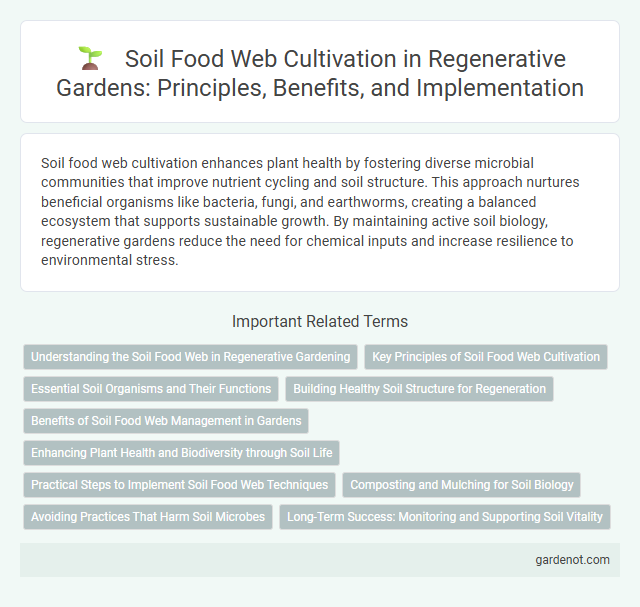Soil food web cultivation enhances plant health by fostering diverse microbial communities that improve nutrient cycling and soil structure. This approach nurtures beneficial organisms like bacteria, fungi, and earthworms, creating a balanced ecosystem that supports sustainable growth. By maintaining active soil biology, regenerative gardens reduce the need for chemical inputs and increase resilience to environmental stress.
Understanding the Soil Food Web in Regenerative Gardening
The soil food web in regenerative gardening consists of a complex network of organisms including bacteria, fungi, protozoa, nematodes, and arthropods that work symbiotically to decompose organic matter and cycle nutrients. Effective soil food web cultivation enhances soil structure, promotes nutrient availability, and increases plant resilience by fostering beneficial microbial activity. Understanding these interactions enables gardeners to implement practices like cover cropping, mulching, and minimal soil disturbance, which support a thriving and balanced soil ecosystem.
Key Principles of Soil Food Web Cultivation
Soil food web cultivation emphasizes maintaining a diverse community of microorganisms, including bacteria, fungi, protozoa, and nematodes, which interact to recycle nutrients and enhance soil fertility. Key principles involve minimizing soil disturbance to protect fungal networks, incorporating organic matter to provide food sources for soil organisms, and promoting biodiversity through crop rotations and polycultures to support balanced microbial populations. These practices improve soil structure, increase nutrient availability, and foster plant health, leading to more resilient and productive regenerative gardens.
Essential Soil Organisms and Their Functions
Essential soil organisms such as bacteria, fungi, protozoa, nematodes, and earthworms play a critical role in the soil food web cultivation by breaking down organic matter, cycling nutrients, and enhancing soil structure. Mycorrhizal fungi form symbiotic relationships with plant roots, improving nutrient and water uptake while promoting plant health. These organisms collectively maintain soil fertility, support plant growth, and drive regenerative garden ecosystems.
Building Healthy Soil Structure for Regeneration
Soil food web cultivation enhances regenerative garden practices by fostering a diverse community of microorganisms that improve soil structure and nutrient cycling. Beneficial bacteria, fungi, protozoa, and nematodes work synergistically, creating porous soil that retains moisture and supports plant root growth. This biological activity increases organic matter decomposition, boosting soil fertility and resilience against erosion and compaction.
Benefits of Soil Food Web Management in Gardens
Soil food web management in gardens enhances nutrient cycling by fostering beneficial microorganisms such as bacteria, fungi, protozoa, and nematodes, which improve soil fertility and plant health. This approach increases soil structure and water retention, reducing erosion and the need for chemical fertilizers while promoting natural disease suppression. By cultivating a balanced soil ecosystem, gardeners achieve sustainable productivity and resilient plant growth in regenerative garden systems.
Enhancing Plant Health and Biodiversity through Soil Life
Soil food web cultivation fosters enhanced plant health by promoting a diverse community of beneficial microorganisms, including bacteria, fungi, protozoa, and nematodes, that collaborate to improve nutrient cycling and disease resistance. This regenerative approach enriches soil biodiversity, creating a balanced ecosystem that supports resilient plant growth and reduces dependency on chemical inputs. Through continuous organic matter decomposition and symbiotic interactions within the soil food web, plants receive essential nutrients more efficiently, leading to sustained vitality and productivity in regenerative gardens.
Practical Steps to Implement Soil Food Web Techniques
Implement practical soil food web cultivation by incorporating compost teas rich in beneficial microbes to enhance soil biodiversity and nutrient cycling. Apply organic mulches and avoid chemical pesticides to maintain a thriving microbial ecosystem that supports plant health. Monitor soil moisture and pH levels regularly to create optimal conditions for microbial activity and soil regeneration.
Composting and Mulching for Soil Biology
Soil food web cultivation thrives on composting and mulching to enhance soil biology by promoting diverse microbial communities and nutrient cycling. Composting transforms organic waste into nutrient-rich humus, feeding beneficial bacteria, fungi, and earthworms essential for soil structure and fertility. Mulching maintains soil moisture, regulates temperature, and provides a continuous source of organic matter, further supporting the complex interactions within the soil food web.
Avoiding Practices That Harm Soil Microbes
Avoiding soil disturbance and minimizing the use of synthetic chemicals preserves the complex interactions within the soil food web, which is crucial for nutrient cycling and plant health. Maintaining organic mulch layers and reducing tillage support diverse microbial populations, enhancing soil structure and water retention. Protecting these beneficial soil microbes promotes resilient, fertile soil essential for regenerative garden success.
Long-Term Success: Monitoring and Supporting Soil Vitality
Soil food web cultivation enhances regenerative garden health by fostering diverse microbial communities that improve nutrient cycling and soil structure. Long-term success depends on regular monitoring of soil vitality indicators such as microbial biomass, organic matter levels, and nutrient availability. Supporting soil life through consistent organic amendments and minimizing disturbance ensures sustained productivity and ecosystem resilience.
Soil food web cultivation Infographic

 gardenot.com
gardenot.com